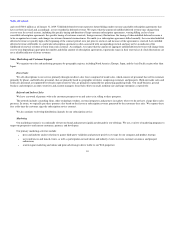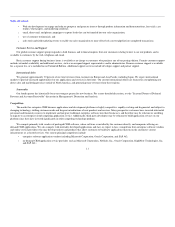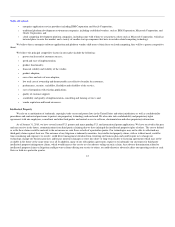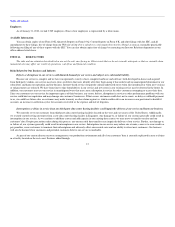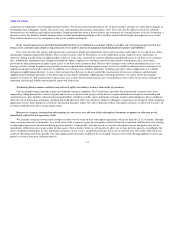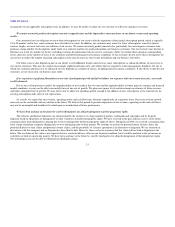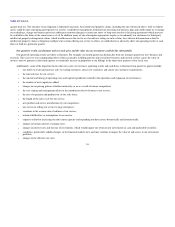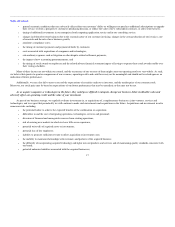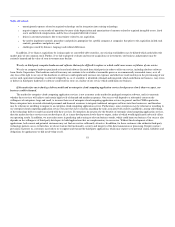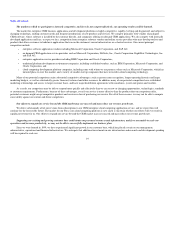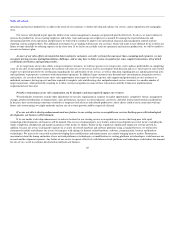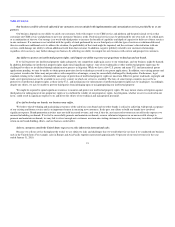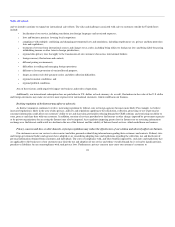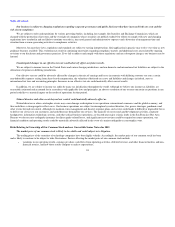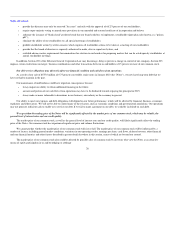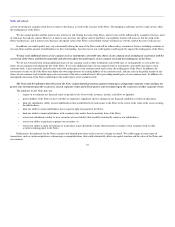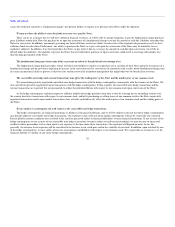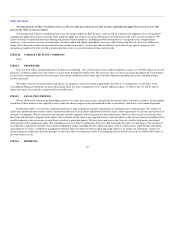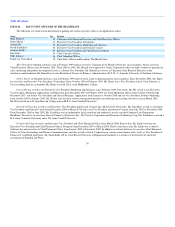Salesforce.com 2009 Annual Report Download - page 23
Download and view the complete annual report
Please find page 23 of the 2009 Salesforce.com annual report below. You can navigate through the pages in the report by either clicking on the pages listed below, or by using the keyword search tool below to find specific information within the annual report.
Table of Contents
operations and increase productivity, to address the needs of our customers, to further develop and enhance our service, and to expand into new geographic
areas.
Our success will depend in part upon the ability of our senior management to manage our projected growth effectively. To do so, we must continue to
increase the productivity of our existing employees and to hire, train and manage new employees as needed. To manage the expected domestic and
international growth of our operations and personnel, we will need to continue to improve our operational, financial and management controls and our
reporting systems and procedures. The additional investments we are making will increase our cost base, which will make it more difficult for us to offset any
future revenue shortfalls by reducing expenses in the short term. If we fail to successfully scale our operations and increase productivity, we will be unable to
execute our business plan.
As more of our sales efforts are targeted at larger enterprise customers, our sales cycle may become more time-consuming and expensive, we may
encounter pricing pressure and implementation challenges, and we may have to delay revenue recognition for some complex transactions, all of which
could harm our business and operating results.
As we target more of our sales efforts at larger enterprise customers, we will face greater costs, longer sales cycles and less predictability in completing
some of our sales. In this market segment, the customer's decision to use our service may be an enterprise-wide decision and, if so, these types of sales would
require us to provide greater levels of education regarding the use and benefits of our service, as well as education regarding privacy and data protection laws
and regulations to prospective customers with international operations. In addition, larger customers may demand more customization, integration services
and features. As a result of these factors, these sales opportunities may require us to devote greater sales support and professional services resources to
individual customers, driving up costs and time required to complete sales and diverting sales and professional services resources to a smaller number of
larger transactions, while potentially requiring us to delay revenue recognition on some of these transactions until the technical or implementation
requirements have been met.
Periodic restructurings of our sales organization can be disruptive and may negatively impact our revenues.
We periodically restructure or make other adjustments to our sales organization in response to market opportunities, competitive threats, management
changes, product introductions or enhancements, sales performance, increases in sales headcount, cost levels, and other internal and external considerations.
In the past, these restructurings sometimes resulted in a temporary lack of focus and reduced productivity; these effects could recur in connection with any
future sales restructurings we might undertake and our rate of revenue growth could be negatively affected.
If we are not able to develop enhancements and new features to our existing service or acceptable new services that keep pace with technological
developments, our business will be harmed.
If we are unable to develop enhancements to and new features for our existing service or acceptable new services that keep pace with rapid
technological developments, our business will be harmed. The success of enhancements, new features and services depends on several factors, including the
timely completion, introduction and market acceptance of the feature or edition. Failure in this regard may significantly impair our revenue growth. In
addition, because our service is designed to operate on a variety of network hardware and software platforms using a standard browser, we will need to
continuously modify and enhance our service to keep pace with changes in Internet-related hardware, software, communication, browser and database
technologies. We may not be successful in either developing these modifications and enhancements or in timely bringing them to market. Furthermore,
uncertainties about the timing and nature of new network platforms or technologies, or modifications to existing platforms or technologies, could increase our
research and development expenses. Any failure of our service to operate effectively with future network platforms and technologies could reduce the demand
for our service, result in customer dissatisfaction and harm our business.
20


